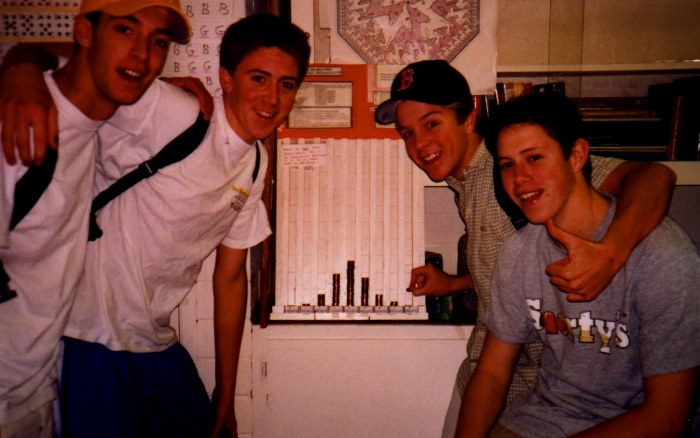
Sanderson M. Smith
Home | About Sanderson Smith | Writings and Reflections | Algebra 2 | AP Statistics | Statistics/Finance | Forum
COIN FLIPPING: A BINOMIAL EXPERIENCE
Here are Cade, -------, Tyler, and Derek doing some coin flipping. They are flipping 8 pennies, and counting the number of heads that appear. If x is the number of heads, then x is a random variable that can assume the values 0,1,2,3,4,5,6,7,8. The board in the middle of this picture has nine columns, labeled 0,1,2,3,4,5,6,7,8. If the students obtain, for example, four heads, they put a penny in the column labeled 4. By experimentation, they are attempting to discover the probability for each x value. As you can note, at this point in the experiment, the "4" column contains the most coins, with the "3" and "5" column a bit behind. The "0" and "8" columns are virtually empty.

Cade, --------, Tyler, and Derek will eventually measure the heights of each of the nine columns, and then use the measurements to determine the empirical probability of obtaining each value of x.
Statistics students realize that this is a binomial setting. The probability of obtaining a value of x is given by the formula
Here are the theoretical probabilities obtained by using this formula:
|
X |
|
|
|
|
|
|
|
|
|
|
Prob. |
|
|
|
|
|
|
|
|
|
I'd be willing to bet that when Cade, --------, Tyler, and Derek do the measurements with the experimental data, their empirical probability values will be reasonably close to the theoretical.
MATH POWER TO ALL.
Home | About Sanderson Smith | Writings and Reflections | Algebra 2 | AP Statistics | Statistics/Finance | Forum
Previous Page | Print This Page
Copyright © 2003-2009 Sanderson Smith